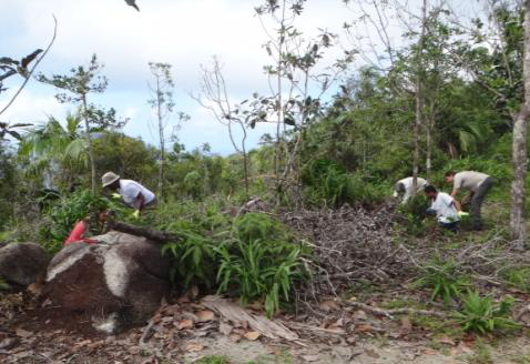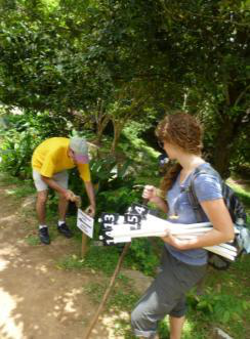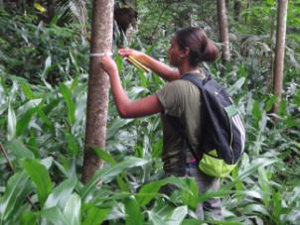Seychelles: A Conservation Nation … with help from PCA!
13.11.14

PCA volunteers maintaining an area of forest cleared of alien species
Seychelles has a reputation as a conservation-oriented nation, with around 50% of its land area now protected - surely the largest proportion of any nation. Seychelles was also one of the first countries to adopt the Global Strategy for Plant Conservation and produced its own national strategy in 2005. A small NGO, the Plant Conservation Action group (PCA), set up in 2002, played a pivotal role in the strategy’s formulation and remains actively engaged in plant conservation and research, vegetation restoration, and education and outreach activities.
With regard to the flora, Seychelles has African, Madagascan and Indo-Malaysian elements, with the latter having a surprising amount of influence, considering the vast distance between the two locations. There are some truly fascinating ancient relict species, with Coco de Mer (Lodoicea maldivica) being perhaps the best-known. Their history is linked to the Gondwana origin of Seychelles’ granitic islands - as a mini-continent that detached from the Indian subcontinent when it drifted northwards away from Africa and Madagascar some 65 million years ago. Frequently, taxonomists seem to have difficulty in placing Seychelles endemics in the classification system of the group to which they are most closely related. So it is interesting that, as more phylogenetic research is carried out on Seychelles endemics, the more distinctive our island species seem to be, with recent research further substantiating the uniqueness and ancient origins of many of them. Thus the conservation work of PCA becomes increasingly important, as to lose one of these species is to lose an important part of the story of plant evolution.
Conservation challenges remain indeed high. Invasive species continue to make inroads into our small remaining patches of native vegetation and human development continues to fragment habitats, so we need to bring broader society ‘on board’. An important part of PCA’s work is therefore to disseminate information and create greater awareness of these unique plants and the need for their conservation. Because PCA is a small NGO with no paid workers and less than 20 local voluntary members, we are most effective when we link up with other organisations - sometimes with other local NGOs (e.g. a joint project to ‘green’ the prison; training for school wildlife club leaders), sometimes with a government body (e.g. the natural history museum - for a joint project to upgrade the herbarium, train young scientists and involve the community). Other times we join forces with the private sector, particularly the tourism sector which is one of the two main pillars of the Seychelles economy, to give advice on vegetation restoration and/or produce a vegetation management plan, provide training, etc.
One of our recent activities has been with a small tourism establishment at Anse Royale on the main island of Mahé - Le Jardin du Roi - one of the few places where visitors can learn about the history of Seychelles in relation to plants. Seychelles was not settled until 1770, at which time it was claimed by the French and was intended to be part of a plan to break the Dutch monopoly of the lucrative spice trade with the Far East. To which end a garden was prepared at Anse Royale and planted with seedlings of nutmeg, clove, cinnamon and pepper, often acquired through risky adventures! Unfortunately this ‘King’s Garden’ of spice plants was destroyed (a complicated story) but the modern-day ‘Jardin du Roi’, located close to the original site, serves as a reminder of this history, as it is a garden of spices, exotic fragrances, tropical fruits and medicinal plants.
This garden reflects Seychelles history following that failed attempt to establish Seychelles as a spice producer, for plants continued to play a central role. Settlers instead extracted timber from the primary forest and then cleared much of it for food production and construction. Agriculture became the mainstay of the economy for two centuries, with several waves of commercial production, ranging from cotton and sugar in the early days, through long years of coconut production (exported as copra), and later vanilla, cinnamon (as bark and leaf oil) and patchouli. Agriculture only lost its dominance in the early 1970s when an airport was constructed and tourism expanded.

Introducing new plant labels and path signs
Visitors enjoy their experience of the family-run Jardin du Roi (JdR), with its small Creole restaurant serving produce from the lush garden. Most fail to notice anything untoward amongst the luxuriant vegetation, but for conservationists and the owners themselves, the forest Nature Trail reflects a negative aspect of Seychelles history - the invasion of alien species. Although the property has small areas of mature endemic palm forest, in much of the rest the native species are outcompeted by alien tree species. PCA and JdR therefore used a locally based international funding opportunity (Global Environment Fund) to link up and carry out vegetation rehabilitation work in the forest, improve the path system, and also prepare interpretive materials showing both the historical and cultural value of the plants in the garden and the importance of native forest conservation work. To this end we also linked with a long-standing PCA partner – ETH in Zurich, Switzerland - a Masters student from the university developed a small environmental museum at JdR. In a one-year project there are limits to what can be achieved, so training of garden staff and agriculture/environment students was an important element to help sustain the work.

A student measuring an alien tree
Native flora is threatened all over the world but especially on islands. The importance of partnerships and joint action cannot be overemphasised in the work of a small NGO in a distant island nation. We depend not only on local support and international funds, but increasingly on regional links for plant conservation work. But with enthusiasm and hard work we feel we have made - and continue to make - significant progress.
Katy Beaver
For further information, go to: www.pcaseychelles.org
To read PCA’s latest newsletter, Kapisen No 17, go to: www.pcaseychelles.org/kapisen.html